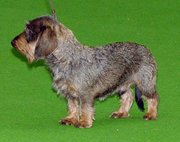Dachshund
|
|
| Dachshund | ||||||||||||||
|---|---|---|---|---|---|---|---|---|---|---|---|---|---|---|
Missing image Std_Dachshund_600.jpg Long-haired standard dachshund | ||||||||||||||
| Alternative names | ||||||||||||||
| ||||||||||||||
| Country of origin | ||||||||||||||
| Germany | ||||||||||||||
| Classification | ||||||||||||||
| ||||||||||||||
| Breed standards (external links) | ||||||||||||||
|
The Dachshund is a short-legged, elongated dog breed of the hound family. From German, Dachshund (literally: "badger dog"), referring to their utility in hunting badgers and other hole-dwelling animals.
| Contents |
Appearance
A full-sized Dachshund averages 12 to 24 lb (5 to 10 kg), while the Miniature variety typically weighs less than 12 lb (5 kg). Colloquially referred to as "wiener dogs" or "sausage dogs" (German Wursthunds), Dachshunds are loyal, playful dogs, known for their propensity to chase small animals and birds. Modern Dachshunds are characterized by their crooked-legs, loose skin and barrel chest, attributes that were deliberately added to the breed to increase their ability to burrow into tight spaces. They come in three coat varieties: Smooth, Longhaired and Wirehaired. H. L. Mencken said that "A dachshund is a half-dog high and a dog-and-a-half long," which is their main claim to fame.
Temperament
The Dachshund is intelligent, energetic and courageous to the point of recklessness, industrious in above and below ground work, with all the senses well-developed. If any kind of shyness is apparent the dog has a major fault. Coat type is often considered to be associated with characteristic temperaments; the long-haired variety, for instance, is considered to be less excitable than the other types because it was cross-bred with the Spaniel to obtain its characteristic long coat.
Health
The breed is known to have spinal problems, due in part to an extremely long spinal column and short rib cage. The risk of injury can be worsened by obesity, which places greater strain on the vertebrae. In order to prevent injury, it is recommended that Dachshunds be discouraged from jumping and taking stairs. It has become increasingly apparent that the occurrence and severity of these problems is largely hereditary, and responsible breeders are working to eliminate this characteristic in the breed.
History
Some have theorized that the early roots of the Dachshund go back to Ancient Egypt, where engravings were made featuring short-legged hunting dogs. But in its modern incarnation, the Dachshund is a creation of European breeders, and includes elements of German, French and English hounds and terriers. Dachshunds have been kept by royal courts all over Europe, including that of Queen Victoria, who was particularly enamored of the breed.
The first verifiable references to the Dachshund, originally named the "Tachs Kriecher" (badger crawler) or "Tachs Krieger" (badger catcher), come from books written in the early 1700s. Prior to that, there exist references to "badger dogs" and "hole dogs", but these likely refer to purposes rather than to specific breeds. The original German Dachshunds were larger than the modern full-size variety, weighing between 30 and 40 lb (14 to 18 kg), and originally came in straight-legged and crook-legged varieties (the modern Dachshund is descended from the latter.) Though the breed is famous for its use in exterminating badgers, Dachshunds were also commonly used for rabbit and fox hunting, for locating wounded deer, and in packs were known to hunt game as large as wild boar.
Traditional colorings and patterns include Red and Black & Tan. Recently, other color and pattern combinations have been developed; it is not uncommon to see Dachshunds with Brown & Tan, Chocolate & Tan, dapple, double dapple, piebald, sable, and even white coats. Unfortunately, some of these colors require extensive inbreeding to obtain; double dapples are often born eyeless or with severely underdeveloped eyes.
According to kennel club standards, the Miniature variety differs from the full-size only by size and weight.
Miscellaneous
Symbol of Germany
Dachshunds have traditionally been viewed as a symbol of Germany, despite their pan-European heritage. During World War I the animals fell so far out of favor in England and the United States that owners were actively encouraged to euthanize their pets. Many Americans began referring to Dachshunds as "liberty pups", and political cartoonists commonly used the image of the Dachshund to ridicule Germany. The stigma of the association was revived to a much reduced extent during World War II, and it quickly faded away following the war's end. German Field Marshal Erwin Rommel was also known for keeping Dachshunds.
Dog Pictures and Clipart
- Pictures of Dogs (http://classroomclipart.com/cgi-bin/kids/imageFolio.cgi?direct=Animals/Dogs)
- Dog Clipart (http://classroomclipart.com/cgi-bin/kids/imageFolio.cgi?direct=Clipart/Animals/Dog_Clipart)
Clipart and Animal Pictures
- Clipart (https://classroomclipart.com/image/category/clipart.htm)
- Animal Clipart (https://classroomclipart.com/image/category/animal-clipart.htm)
- Animal Animated Clipart (https://classroomclipart.com/clipart/Animations/Animals.htm)
- Pictures of Animals (https://classroomclipart.com/image/category/animal-photos.htm)
- Amphibian Clip Art, Pictures and Photogaphs (https://classroomclipart.com/image/category/amphibian-clipart.htm)
- Farm Animal Clip Art, Pictures and Photographs (https://classroomclipart.com/image/category/farm-animal-clipart.htm)
- Mammal Clip Art, Pictures and Photographs (https://classroomclipart.com/image/category/mammal-clipart.htm)
- Marine Animal Clip Art, Pictures and Photographs (https://classroomclipart.com/image/category/marine-life-clipart.htm)
- Reptile Clip Art, Pictures and Photographs (https://classroomclipart.com/image/category/reptile-clipart.htm)
- Spider Clip Art, Pictures and Photographs (https://classroomclipart.com/image/category/spider-clipart.htm)




